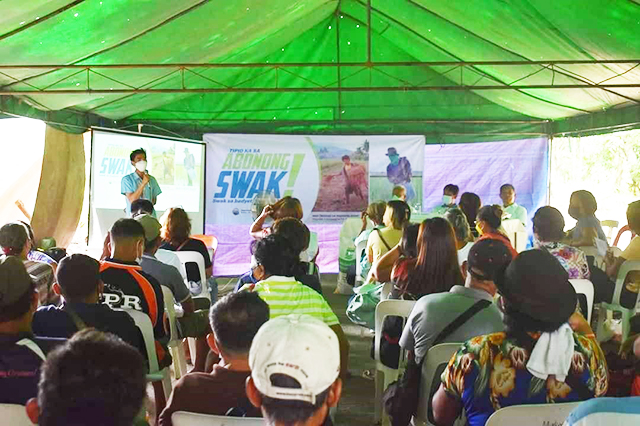
Rice farmers in Masbate City, Masbate; Calbayog City, Samar; and Santa Maria, Laguna expressed willingness to apply combination of organic and inorganic fertilizer during the launch of the “Abonong Swak! Swak sa Budget! Swak sa Palay!” campaign by the Philippine Rice Research Institute (PhilRice) together with the Bureau of Soil and Water Management (BSWM).
The “Abonong Swak” campaign is an initiative of the Rice Competitiveness Enhancement Fund – Rice Extension Services Program (RCEF-RESP), which promotes strategic nutrient management practices to achieve balanced fertilization, which could help farmers lower their farming expenses. The campaign features organic and inorganic fertilizer combinations to cater to the budget of farmers and current yield.
“We, farmers, should know what type of fertilizer to use, when to apply, and how much we should apply on our crops. As we will now start planting, we will also try the decision support tools introduced to us like the Leaf Color Chart (LCC). After this cropping season, we will try to apply chicken manure during the fallow period,” Belen G. Bestudio of Brgy. Anislag said.
Maribel Jalalon, BSWM chief agriculturist, stated that aside from yield increase, adoption of the Balanced Fertilizer Strategy can help rehabilitate degraded rice soils. It can also improve the soil’s physical properties and maintain balanced soil nutrients and their availability.
In Sta. Maria, Laguna, nutrient management expert Wilfredo Collado discussed to more than 30 trainees of the Sweet Nature Farms farm school the benefits of combining organic fertilizer with inorganic fertilizer.
“Rice straws, once decomposed, are excellent nitrogen source for the soil. Rice straw as fertilizer could help farmers purchase fewer bags of urea,” he said.
Collado further discussed strategies that could help improve the nutrient management practices of farmers, including the three fertilizer recommendations or “combos” they can choose from based on their current yield and available budget.
“Farmers targeting a yield of 5 tons normally use eight bags of fertilizer. But based on our computations, they can use 4.5 bags, which could help them save up to P4,000/ha,” he said.
Furthermore, Collado recommended using nutrient decision support tools such as Minus-One Element Technique kits, soil testing kits, LCC, and ICT-based tools available online to boost rice yield and to avoid applying fertilizers sparingly or excessively.
Farm School Director Suzette Sales expressed her appreciation for the campaign.
“We are very thankful for opportunities like this that allow us to learn and improve the skills of farmer-trainees. We are committed to make a difference in the agriculture sector of our country,” Sales said.
The technical briefing activity was also participated by Agricultural Training Institute IV-A and DA-Regional Field Office 4A.
The RCEF-Extension Program is a component of Republic Act 11203 or Rice Tariffication Law, which allots P10 billion fund every year for rice farmers. The program is being implemented by DA-PhilRice, DA-PHilMech, DA-ATI, and TESDA in partnership with local government units and other intermediaries.




